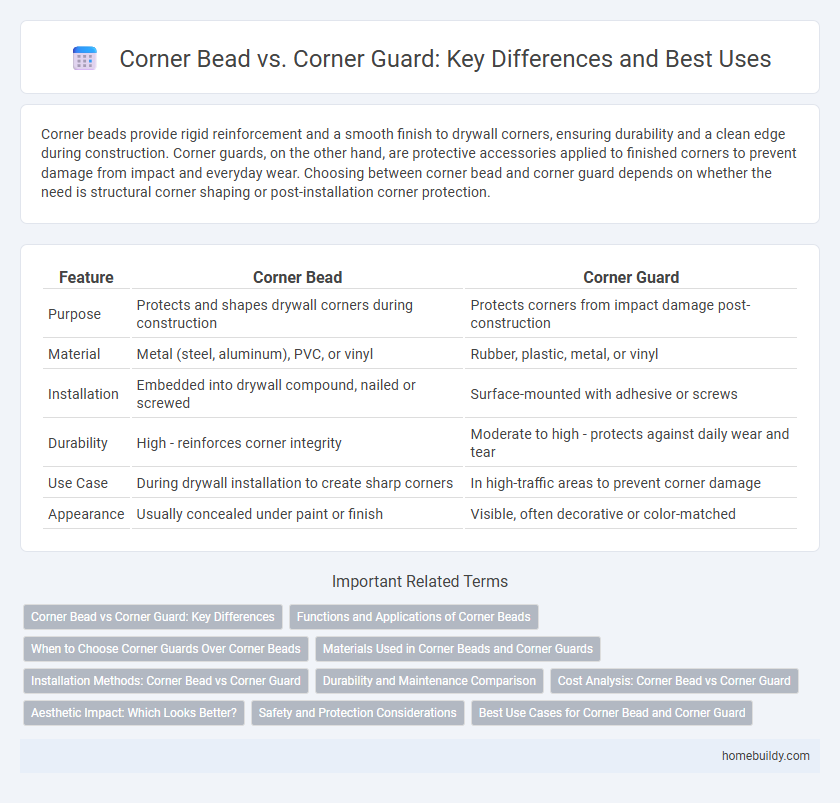Corner beads provide rigid reinforcement and a smooth finish to drywall corners, ensuring durability and a clean edge during construction. Corner guards, on the other hand, are protective accessories applied to finished corners to prevent damage from impact and everyday wear. Choosing between corner bead and corner guard depends on whether the need is structural corner shaping or post-installation corner protection.
Table of Comparison
| Feature | Corner Bead | Corner Guard |
|---|---|---|
| Purpose | Protects and shapes drywall corners during construction | Protects corners from impact damage post-construction |
| Material | Metal (steel, aluminum), PVC, or vinyl | Rubber, plastic, metal, or vinyl |
| Installation | Embedded into drywall compound, nailed or screwed | Surface-mounted with adhesive or screws |
| Durability | High - reinforces corner integrity | Moderate to high - protects against daily wear and tear |
| Use Case | During drywall installation to create sharp corners | In high-traffic areas to prevent corner damage |
| Appearance | Usually concealed under paint or finish | Visible, often decorative or color-matched |
Corner Bead vs Corner Guard: Key Differences
Corner bead is primarily used in drywall installations to create smooth, reinforced edges that prevent cracking and chipping, whereas corner guards protect existing corners from impact damage. Corner beads are typically embedded in joint compound for a seamless finish, making them ideal for new construction, while corner guards are surface-mounted and designed for high-traffic areas requiring extra durability. Material differences include metal or vinyl for beads versus rubber or plastic for guards, reflecting their distinct protective and aesthetic purposes.
Functions and Applications of Corner Beads
Corner beads reinforce drywall corners by providing a straight edge and protecting against damage during everyday wear and impact. Commonly used in residential and commercial construction, corner beads improve corner durability and create a smooth surface for painting or finishing. Unlike corner guards, which are primarily decorative and installed after finishing, corner beads are integrated into the drywall installation process to ensure structural integrity.
When to Choose Corner Guards Over Corner Beads
Corner guards are preferred over corner beads in high-traffic areas where walls are prone to frequent impact and damage, providing durable protection that is easier to replace. When aesthetics and surface texture are priorities, especially in commercial or residential spaces requiring a finished look, corner guards offer a variety of materials and designs unmatched by corner beads. Selecting corner guards is ideal for enhancing wall longevity and reducing maintenance costs while maintaining safety in environments such as hospitals, schools, and offices.
Materials Used in Corner Beads and Corner Guards
Corner beads are typically made from materials such as galvanized steel, aluminum, or vinyl, chosen for their rigidity and ability to create sharp drywall corners. Corner guards, on the other hand, are often crafted from softer materials like rubber, plastic, or flexible vinyl, designed to absorb impact and protect walls in high-traffic areas. The choice of materials significantly impacts durability and functionality, with corner beads providing structural reinforcement and corner guards offering impact resistance.
Installation Methods: Corner Bead vs Corner Guard
Corner bead installation involves embedding the metal or plastic strip into wet joint compound, followed by sanding and painting for a smooth, reinforced corner finish. Corner guard installation typically requires adhesive backing or mechanical fasteners like screws or clips to attach the protective strip directly onto the wall corner surface. While corner beads integrate into drywall finishing, corner guards offer a surface-mounted solution for immediate protection and easy replacement.
Durability and Maintenance Comparison
Corner beads are typically made from galvanized steel or aluminum, offering superior durability against impacts and prolonged exposure to moisture compared to plastic or rubber corner guards. They require minimal maintenance, as their metal composition resists chipping, cracking, and corrosion, reducing the need for frequent repairs or replacements. Corner guards, while easier to install and replace, tend to wear down faster and may require more frequent upkeep to maintain their appearance and protective function.
Cost Analysis: Corner Bead vs Corner Guard
Corner bead typically costs less than corner guards due to its simpler materials like galvanized steel or plastic, making it an affordable choice for drywall finishing. Corner guards, often made from more durable materials such as rubber, vinyl, or metal, have a higher upfront cost but provide longer-lasting protection against impact damage. When considering long-term maintenance expenses, corner guards may offer better value by reducing the need for frequent repairs compared to corner bead.
Aesthetic Impact: Which Looks Better?
Corner bead offers a seamless, smooth finish that enhances wall corners with a clean, professional appearance ideal for drywall installations. Corner guard, while providing robust protection against damage, often adds a visible, bulky element that can detract from the overall aesthetic. For spaces prioritizing sleek, polished design, corner bead tends to deliver a more visually appealing result.
Safety and Protection Considerations
Corner beads provide essential reinforcement to drywall corners, preventing cracks and damage while maintaining structural integrity during impact. Corner guards, typically made from rubber or plastic, primarily protect against minor abrasions and collisions in high-traffic areas, offering a softer barrier that reduces injury risk. For optimal safety and protection, selection depends on the environment; corner beads ensure durability for construction stability, whereas corner guards enhance user safety in sensitive or crowded spaces.
Best Use Cases for Corner Bead and Corner Guard
Corner bead is ideal for drywall corners requiring precise reinforcement and a clean, sharp finish, effectively preventing cracks and wear in high-traffic areas. Corner guards are best suited for protecting existing wall corners from impact damage, especially in commercial or high-traffic environments where longevity and ease of replacement are priorities. Using corner bead ensures a durable, professional drywall edge, while corner guards provide practical protection where wall damage is likely.
corner bead vs corner guard Infographic

 homebuildy.com
homebuildy.com